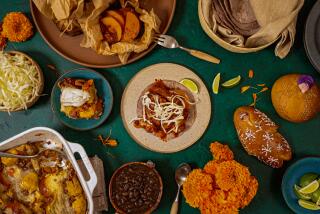The joys of Mexican vegetarian dishes
- Share via
My Mexican grandfather used to say that salads were for rabbits. My Mexican father thinks a good steak cures any stomach ailment. And a Mexican friend used to joke that a pet pig that lived near my old Westside neighborhood would last approximately two seconds in his Eastside neighborhood before being kidnapped, placed on a spit and barbecued over an outdoor pit.
Indeed, Mexicans love their meat, and the cuisine is renowned for its carnitas, tacos al pastor, beef stews and barbecued goat. But what about Mexican vegetarian meals?
Though I am not a vegetarian, increasingly I have come to enjoy the simplicity and lightness of such meals. But looking through Mexican cookbooks in search of meatless recipes, I found that the pickings were slim. Mexican vegetables such as chayote, zucchini, corn, verdolagas (purslane) and sweet potatoes seem to be used most often to augment stews or complement meat dishes.
Some of the vegetarian dishes I did find consisted of such New Age California inventions as substituting raw walnuts for “taco meat” or stuffing enchiladas with tofu.
But meatless dishes actually have a long history in Mexican cuisine. The diet of the Aztecs and other Indians was heavy on grains, fruits and vegetables, and it wasn’t until the Spaniards colonized Mexico that the carnivorous culture of pork and beef really became the backbone of what we now consider Mexican food.
One of the biggest obstacles to eating purely vegetarian food in Mexico today is the use of lard and chicken stock. But if you are cooking at home, a lot of onions and a dash of olive oil will make up for the missing lard in most dishes, and vegetable broth is an easy substitute for chicken stock.
And it’s not just a matter of substitutions. It turns out there are many purely vegetarian dishes that are authentically Mexican, filling and interesting in their complexity. One of my favorite ingredients is huitlacoche — known here as corn fungus or corn smut. There is nothing subtle or simple about huitlacoche. It’s true that its black fungus-y appearance is a bit startling, but its pungent, earthy taste combines beautifully with sautéed serrano peppers, chopped onion and garlic. Nobel laureate Octavio Paz wrote that huitlacoche, which the Aztecs also enjoyed, is a symbol of Mexican culture with its communion of flavors, passionate color and robustness.
Growing up, we would warm a tortilla on the comal (a metal plate that can be placed directly over the flame) with a slice of Oaxaca cheese and a generous helping of huitlacoche and fold it over like a quesadilla. You can also leave out the cheese and eat it like a taco. In some of Mexico’s finest restaurants, huitlacoche is treated like a truffle. Mexico City’s Hacienda de los Morales is famous in part because of its crepes smothered with huitlacoche. Another popular dish that is a remnant of the French influence in Mexico is a huitlacoche soufflé.
Huitlacoche is difficult to find fresh in Southern California, but the canned version makes a very good substitute.
But Mexican vegetarian dishes don’t have to be so exotic. Mushrooms sauteed with Pasilla chile and the herb epazote, both of which can be bought at just about any Mexican market, is another favorite of mine. I like to cook oyster, shiitake and thinly sliced brown mushrooms with lots of garlic and then serve it over a bed of rice and a mixed greens salad on the side.
Even the humble zucchini can take a starring role. Stew cubed squash with onion, serrano peppers, a little tomato and corn, and use that as a taco filling. In summer, I add zucchini blossoms.
A major contributor to my vegetarian meals is the poblano chile, a slightly sweet and usually mild pepper that has a rich, smoky flavor. Rajas — peeled and cut poblano strips with sauteed onions — make a terrific taco stuffing, but I also use it as the “meat” for a lasagna. (Why not? I live in Los Angeles, where we create our own cuisine.)
Layer this with noodles and a Mexican version of ricotta (mix sour cream and salty cotija cheese in the food processor to the consistency of cottage cheese). It’s so easy to make and so delicious that it’s now a staple of my dinner parties.
Who needs tofu enchiladas and walnut tacos?
More to Read
Eat your way across L.A.
Get our weekly Tasting Notes newsletter for reviews, news and more.
You may occasionally receive promotional content from the Los Angeles Times.










